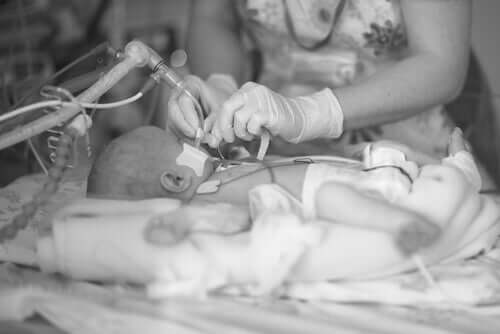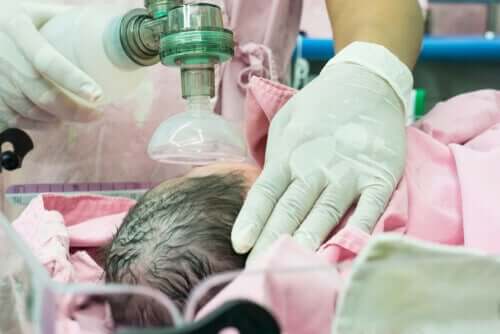Most Common Neonatal Respiratory Diseases

Neonatal respiratory diseases are quite common and must be evaluated and treated in time in order to avoid major complications.
The lungs are the last organ to develop in the fetus before birth. Thus, they’re susceptible to major problems. If the baby is born premature, their lungs may not be fully developed, and they may be more exposed to risk factors.
Genetic factors can also cause breathing problems in newborns. Other causative factors can be complicated deliveries, characterized by reduced fetal blood circulation, or infections the baby contracts after birth.
In all cases, treatment is key because respiratory diseases can have serious consequences. In fact, they’re one of the main causes of death in newborns.
This article may interest you: Respiratory Diseases in Newborns
What are the symptoms of neonatal respiratory diseases?
The main symptoms that doctors try to identify right after delivery and in the days after are:
- Not breathing
- Shallow breathing
- Respiratory sinus arrhythmia
- Snoring when breathing
- Excess mucus
- Pulmonary retractions

Most common neonatal respiratory diseases
There are many different types of neonatal respiratory diseases. The most common are:
Apnea
It occurs when the baby stops breathing for about 20 seconds. It usually develops when the lungs are underdeveloped.
When there’s apnea, the baby’s pulse may decrease. Bradycardia (a slower than normal heart rate) and bluish skin discoloration known as cyanosis can occur.
It’s common in babies born by Caesarean section or premature babies. This complication usually disappears in less than 24 hours, when the baby is given oxygen.
Read on to learn more: How to Care for a Newborn Baby’s Belly Button
Pneumonia
Premature babies are at a high risk of developing pneumonia because their lungs aren’t fully developed.
Meconium is the first stool a newborn baby expels. Sometimes, the baby can breathe it in during delivery. This can cause an infection that leads to pneumonia.
Respiratory distress syndrome (RDS)
This condition is also more common in premature babies, especially those born between 36 and 39 weeks of pregnancy.
At this stage of the baby’s development, pulmonary surfactant hasn’t yet been produced. This is a liquid that protects the lungs and helps them inflate with air without pressing on the alveoli. Thus, it keeps them clear. The result here could be a collapsed lung.
Bronchopulmonary dysplasia (BDP)
This is a complication that isn’t innate to the baby. A baby contracts it due to the treatments they receive when they’re premature. Giving a baby oxygen, while necessary to save their life, can damage their delicate lungs. If this happens, the baby may have trouble breathing.
Pneumothorax
This occurs when, at birth, there’s air between the lung and the thorax, causing pressure in the newborn. When this condition occurs, the baby has bluish skin and breathing problems. Thus, medical professionals must treat it immediately by inserting a catheter that helps to remove the trapped air.
Other respiratory diseases
There are other less common but equally serious neonatal respiratory diseases:
- Congenital bronchiectasis. Airway inflammation caused by an infection.
- Pulmonary hypoplasia. A congenital anomaly that causes incomplete lung development.
- Congenital pneumonia. An inflammation of the lung tissue not caused by infections.

Can neonatal respiratory diseases be prevented?
Respiratory diseases are difficult to predict and prevent. Therefore, experts advise following these tips during pregnancy:
- Go to all your medical check-ups
- Follow a healthy diet
- Avoid smoking
- Avoid drinking alcohol
- Don’t use drugs
In either case, maintaining a healthy pregnancy helps prevent preterm labor and lowers the risk of underdeveloped lungs.
All cited sources were thoroughly reviewed by our team to ensure their quality, reliability, currency, and validity. The bibliography of this article was considered reliable and of academic or scientific accuracy.
- Bronchopulmonary dysplasia. (n.d.)
lung.org/lung-health-and-diseases/lung-disease-lookup/bronchopulmonary-dysplaia/ - Chronic lung disease. (n.d.)
ucsfbenioffchildrens.org/conditions/chronic_lung_disease/ - Common conditions treated in the NICU. (2014, August)
marchofdimes.com/baby/common-conditions-treated-in-the-nicu.aspx - Respiratory distress syndrome. Kopelman, A. E. (n.d.).
merckmanuals.com/home/children’s-health-issues/problems-in-newborns/respiratory-distress-syndrome - Neonatal respiratory distress syndrome. Medlineplus. https://medlineplus.gov/ency/article/001563.htm
This text is provided for informational purposes only and does not replace consultation with a professional. If in doubt, consult your specialist.








